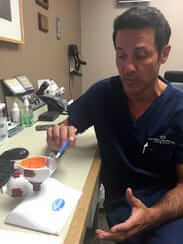Article courtesy of The Spectrum.
Author: Jud Burkett, jburkett@thespectrum.com
9:01 a.m. MDT September 5, 2016

For the majority of people recovering from cataract surgery, a regimen of eye drops are prescribed in order to prevent infections in the eye.
For three to four weeks, those patients need to apply two or three different drops, three or four times a day. On top of the inconvenience of having to remember to regularly administer these drops, the prescriptions can cost hundreds of dollars.
Dr. Jason Ahee and his colleagues at Dixie Ophthalmic Specialists at the Zion Eye Institute are working to change that standard of care, not just for their own patients but, they hope, for everyone recovering from cataract surgery.
“I had been looking at the preliminary research on intraocular antibiotic injections,” Ahee said. “It’s not a new thing to give medication injections into and around the eyeball but it’s almost surprising to think that we haven’t thought of doing this sooner for cataract surgery.”
The technique involves injecting antibiotic medicine into the eye during the cataract operation, during which surgeons remove the patient’s clouded lens and replace it with a new one. While dropless cataract surgery has been offered in the past, this new technique involves injecting the antibiotic, not all the way into the center of the eye, but just into the area between the cornea and the lens.
After reading about the potential benefits of dropless cataract surgery and talking about the idea with other doctors at conferences and other meetings, Ahee pitched the idea to his fellow surgeons at Dixie Ophthalmic.
“As a group, we talked about it, thought about it, and we thought this could be a really be a beneficial thing for our patients. This could help them in every way,” Ahee said. “So we developed our own protocol where we can deliver the antibiotic directly to the eye during the cataract surgery so the patient doesn’t have to take any eye drops at all.”
The surgeons at Dixie Ophthalmic began using the technique on a limited basis late last year, but their success with the technique and the outcomes they were seeing led them to increase their use of the dropless surgery.
“We started out slow,” Ahee said. “We were just doing a handful of cases to get more comfortable with the technique but, at this stage, we’re doing everybody dropless. We’ve been doing everybody dropless since the beginning of the year.”
Since they began using the new technique, doctors at Dixie Ophthalmic have now performed the dropless surgery more than 1,500 times.
Mesquite resident Gene Gruenig had cataract surgery at Dixie Ophthalmic in June and was one of the patients who benefited from the use of this new technique.
“There was nothing to it,” Gruenig said. “When you get your surgery, you’re all done. You don’t have to mess with (drops), which is great.”
Gruenig has had cataract surgery once before, about six years ago, in Billings, Montana, and he wasn’t a fan of the eye drops.
“It was no good,” Gruenig said. “I’m claustrophobic, so anything that gets around my eyes, I don’t like. And the drops, there’s one or two of them that are fairly expensive. They’re just a pain. It was just a lot more convenient with the dropless.”
An added bonus for patients is the dropless surgery comes at no out-of-pocket expense.
“The surgery center absorbs the cost,” Ahee said. “We believe so strongly in this technique that we’re okay with that, it’s worth it to get the safety and the better results.”
With cataract surgery listed as the most common surgery performed in the United States, the potential to save a great number of people the inconvenience and cost of having to use eye drops after the procedure could add up to significant savings of time and money. “About half of Americans over the age of 80 will develop a cataract,” said Zachary Cox, the associate administrator at Dixie Ophthalmic. “It’s not a question of ‘if,’ it’s a question of ‘when.’”
Ahee said they’re so pleased with the success they’re seeing, he hopes to publish the results so other surgeons can benefit from the use of the technique.
“This seems to be a really big deal,” he said. “Not every doctor is going to adopt this type of technique right away, but we’re hoping, if we can publish some data, when they see how beneficial this is, I would hope they would look at it and feel more comfortable. This works. Not just theoretically, it’s actually working in the real world.”
For his part, Gruenig said he couldn’t be happier with his results.
“Everything is a lot brighter, it makes quite a bit of difference,” he said. “That cataract is just a cloud over your eye and this just clears everything up. I think people would be plumb happy with the dropless.”
Follow Jud Burkett on Twitter and Instagram @judburkett. Email him at jburkett@thespectrum.com or call him at 435-674-6262.
